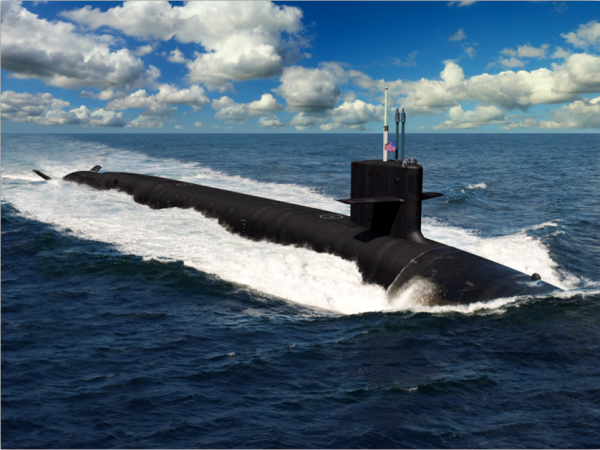The United States is developing the Columbia Class ballistic missile submarine (SSBN), formerly know as the Ohio Replacement SSBN program, to maintain a continuous at-sea strategic deterrence as the current force of 14 Ohio Class SSBNs reach the end of their unprecedented 42 year service life in the late 2020s. Columbia Class is the United States Navy’s Number 1 acquisition priority.
The Columbia Class SSBN program consists of a minimum of 12 submarines to meet the requirements for U.S. strategic deterrent force structure as set forth in the 2018 Nuclear Posture Review. The Columbia Class program completed Acquisition Milestone B on January 4, 2017 and is in the Engineering and Manufacturing Development Phase.
Current plans call for a minimum of 12 Columbia Class SSBNs, with initial construction of the USS COLUMBIA (SSBN 826) beginning in 2021. According to the Chief of Naval Operations, Admiral Richardson, SSBNs are essential to national security and are ”…foundational to our survival as a nation.” (January 2016). Because these new SSBNs will be in service until 2080, a new ship design that advances critical stealth capabilities and survivability is required.
SSBNs carry 70 percent of the U.S. operational nuclear deterrent arsenal and are the most survivable leg of the nuclear triad. The Ohio Class SSBNs begin to reach their end of service life in 2027. Between 2032 and 2040, the United States Navy will only have the minimum SSBN force structure necessary to meet the United States Strategic Command (USSTRATCOM) strategic deterrent requirements. Delivery of the Columbia Class on schedule maintains the minimum force structure necessary to meet USSTRATCOM’s requirements. The existing Ohio Class SSBNs’ service lives have been extended from an initial 30 years to an unprecedented 42 years. There is no margin to further extend the service life of the current SSBNs which will begin to reach their end of service life in 2027.
The Columbia Class SSBN program will provide a credible deterrent at the lowest possible cost. The program is leveraging lessons learned from the currently in production Virginia Class fast attack submarine and existing Ohio Class SSBN. Procurement cost estimates have already decreased nearly 40% ($50 Billion) since program inception. Flexible acquisition authorizations such as multiyear procurement, continuous production, block buy contracting, and advance multi-class procurement can further reduce costs. Both the Congressional Research Service and Congressional Budget Office has stated that cost savings on the order of 10% could be achieved with additional acquisition authorities.
The Columbia Class SSBN is designed with a 42 year service life. The reactor is designed for the boat service life, eliminating the need mid-life reactor refueling overhaul (typically takes 2 years) which saves an estimated $40 Billion over the life of the class. The elimination of the mid-life reactor refueling allows 12 Columbia Class SSBNs to replace the existing 14 Ohio Class SSBNs, reducing overall upfront procurement cost. Despite being approximately the same size, 16 ballistic missile launch tubes on Columbia Class submarine will replace 24 tubes on the Ohio Class – reducing construction, operations, and maintenance costs.
The Common Missile Compartment (CMC) represents another cost savings for the Columbia Class. CMC is a joint United States and United Kingdom investment and design collaboration for the each country’s next SSBN class. The current U.S. Ohio Class and U.K. Vanguard Class SSBNs utilize the Trident II strategic weapons system with the D5 submarine launched ballistic missile (SLBM). In lieu of developing a new SLBM, both the U.S. Columbia Class and U.K. Dreadnought Class will utilize the current Trident II D5 SLBM. As such, the CMC was developed rather than having each nation design their own missile compartment for their next SSBN classes during the same timeframe. This joint effort is saving each country hundreds of millions of dollars. The CMC design and production must stay on schedule to support the ongoing construction of the U.K.’s new Dreadnought Class SSBN.
Both the Columbia and Dreadnought SSBNs will host the upgraded Trident II strategic weapons system with D5 Life Extension SLBMs. The Trident II D5 SLBM life extension program will reduce the risks to both national SSBN programs and eliminated the cost of developing a new SLBM while designing the next generation SSBNs. This ensures the new U.S. Columbia Class and U.K. Dreadnought Class SSBNs will be ready for deterrent patrols with operational missiles.
The Columbia Class SSBN is already well into design. Advance construction has started and must be fully supported to prevent a gap in U.S. deterrent capabilities when the Ohio Class SSBNs begin to retire.

 Submarine Industrial Base Council
Submarine Industrial Base Council